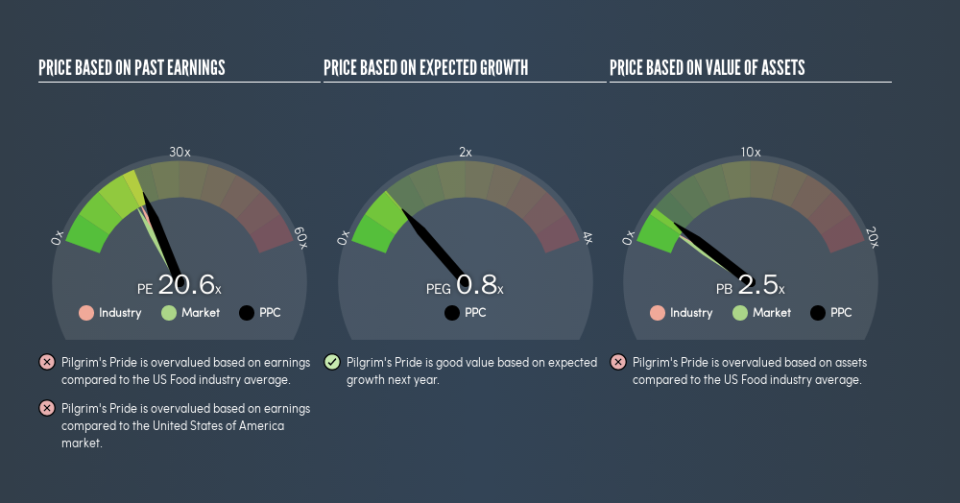Should We Worry About Pilgrim’s Pride Corporation’s (NASDAQ:PPC) P/E Ratio?

The goal of this article is to teach you how to use price to earnings ratios (P/E ratios). We’ll show how you can use Pilgrim’s Pride Corporation’s (NASDAQ:PPC) P/E ratio to inform your assessment of the investment opportunity. Based on the last twelve months, Pilgrim’s Pride’s P/E ratio is 20.57. That is equivalent to an earnings yield of about 4.9%.
Check out our latest analysis for Pilgrim’s Pride
How Do I Calculate A Price To Earnings Ratio?
The formula for price to earnings is:
Price to Earnings Ratio = Share Price ÷ Earnings per Share (EPS)
Or for Pilgrim’s Pride:
P/E of 20.57 = $20.49 ÷ $1.0 (Based on the trailing twelve months to December 2018.)
Is A High Price-to-Earnings Ratio Good?
A higher P/E ratio implies that investors pay a higher price for the earning power of the business. All else being equal, it’s better to pay a low price — but as Warren Buffett said, ‘It’s far better to buy a wonderful company at a fair price than a fair company at a wonderful price.’
How Growth Rates Impact P/E Ratios
If earnings fall then in the future the ‘E’ will be lower. Therefore, even if you pay a low multiple of earnings now, that multiple will become higher in the future. A higher P/E should indicate the stock is expensive relative to others — and that may encourage shareholders to sell.
Pilgrim’s Pride shrunk earnings per share by 64% over the last year. And it has shrunk its earnings per share by 6.6% per year over the last five years. This might lead to muted expectations.
How Does Pilgrim’s Pride’s P/E Ratio Compare To Its Peers?
The P/E ratio essentially measures market expectations of a company. As you can see below, Pilgrim’s Pride has a higher P/E than the average company (19.1) in the food industry.
Its relatively high P/E ratio indicates that Pilgrim’s Pride shareholders think it will perform better than other companies in its industry classification. Clearly the market expects growth, but it isn’t guaranteed. So further research is always essential. I often monitor director buying and selling.
Remember: P/E Ratios Don’t Consider The Balance Sheet
The ‘Price’ in P/E reflects the market capitalization of the company. Thus, the metric does not reflect cash or debt held by the company. In theory, a company can lower its future P/E ratio by using cash or debt to invest in growth.
Such expenditure might be good or bad, in the long term, but the point here is that the balance sheet is not reflected by this ratio.
How Does Pilgrim’s Pride’s Debt Impact Its P/E Ratio?
Pilgrim’s Pride has net debt worth 39% of its market capitalization. This is a reasonably significant level of debt — all else being equal you’d expect a much lower P/E than if it had net cash.
The Verdict On Pilgrim’s Pride’s P/E Ratio
Pilgrim’s Pride’s P/E is 20.6 which is above average (17.5) in the US market. With some debt but no EPS growth last year, the market has high expectations of future profits.
When the market is wrong about a stock, it gives savvy investors an opportunity. As value investor Benjamin Graham famously said, ‘In the short run, the market is a voting machine but in the long run, it is a weighing machine.’ So this free visualization of the analyst consensus on future earnings could help you make the right decision about whether to buy, sell, or hold.
You might be able to find a better buy than Pilgrim’s Pride. If you want a selection of possible winners, check out this free list of interesting companies that trade on a P/E below 20 (but have proven they can grow earnings).
We aim to bring you long-term focused research analysis driven by fundamental data. Note that our analysis may not factor in the latest price-sensitive company announcements or qualitative material.
If you spot an error that warrants correction, please contact the editor at editorial-team@simplywallst.com. This article by Simply Wall St is general in nature. It does not constitute a recommendation to buy or sell any stock, and does not take account of your objectives, or your financial situation. Simply Wall St has no position in the stocks mentioned. Thank you for reading.

